Each overtime rule contains the overtime settings for applied locations.
When an overtime rule is applied to a location, projected overtime will be calculated for that location on the schedule calendar. Users will then receive overtime warnings when creating or publishing shifts, and projected overtime will be included in scheduled labor reporting.
If the system preferences setting for overtime tracking is set to ‘R365 OT Rules’, the overtime rule for the location is used to calculate actual overtime hours and wages based on polled labor punches.
Learn more about overtime rules and labor rules in R365.
On an overtime rule, users can:
Delete the rule
Security
The following Permissions are associated with overtime rules:
Labor → Labor Rules → Overtime Rules
View Overtime Rules
Edit Overtime Rules
Create Overtime Rules
Delete Overtime Rules
These permissions can be added to custom user roles or individual users. The Permission Access report can be used to determine which user roles or users already have these permissions assigned. For more information, see User Setup and Security.
Navigation
Navigation Menu
Navigate to the Labor Rules page.
Select the Overtime Rules tab.
Select the desired overtime rule.
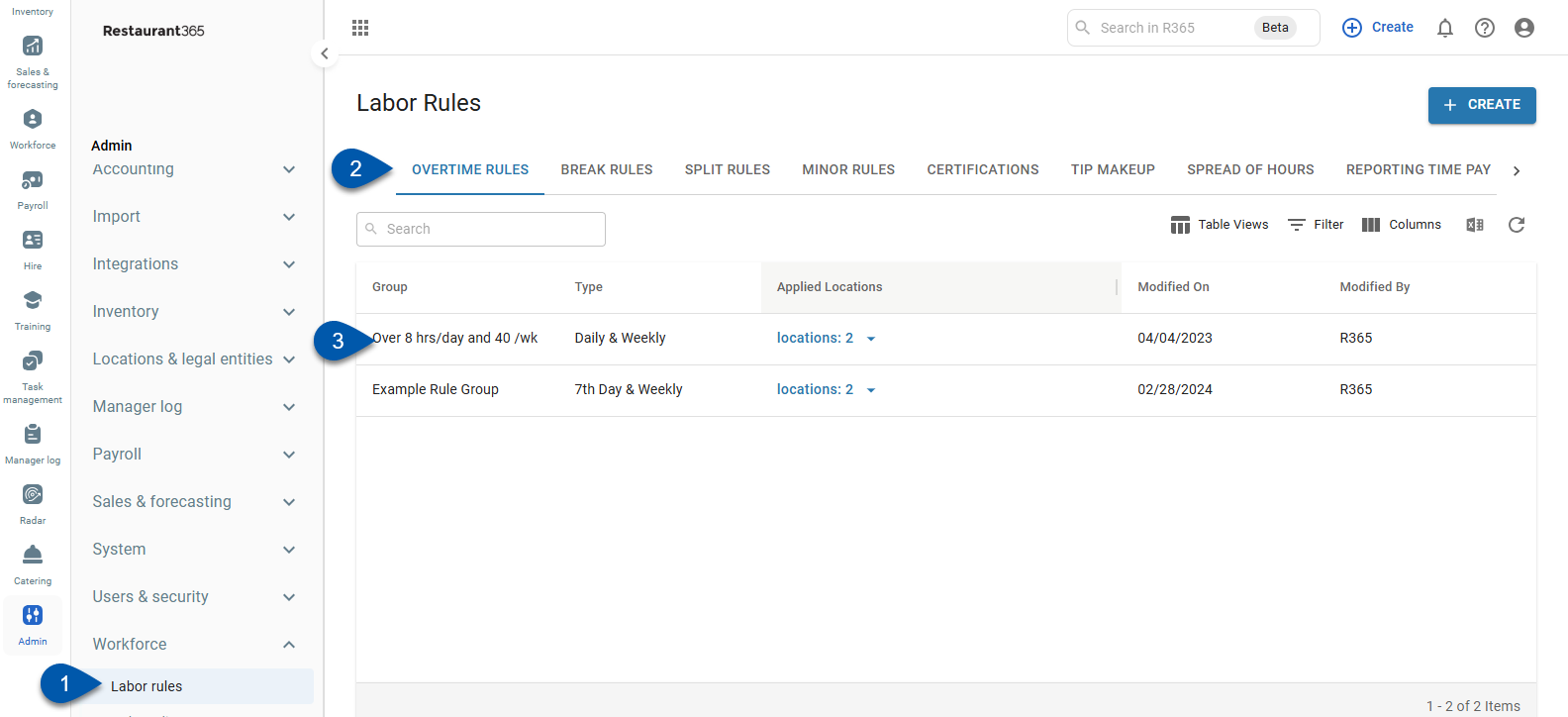
Overtime Rules Buttons and Fields
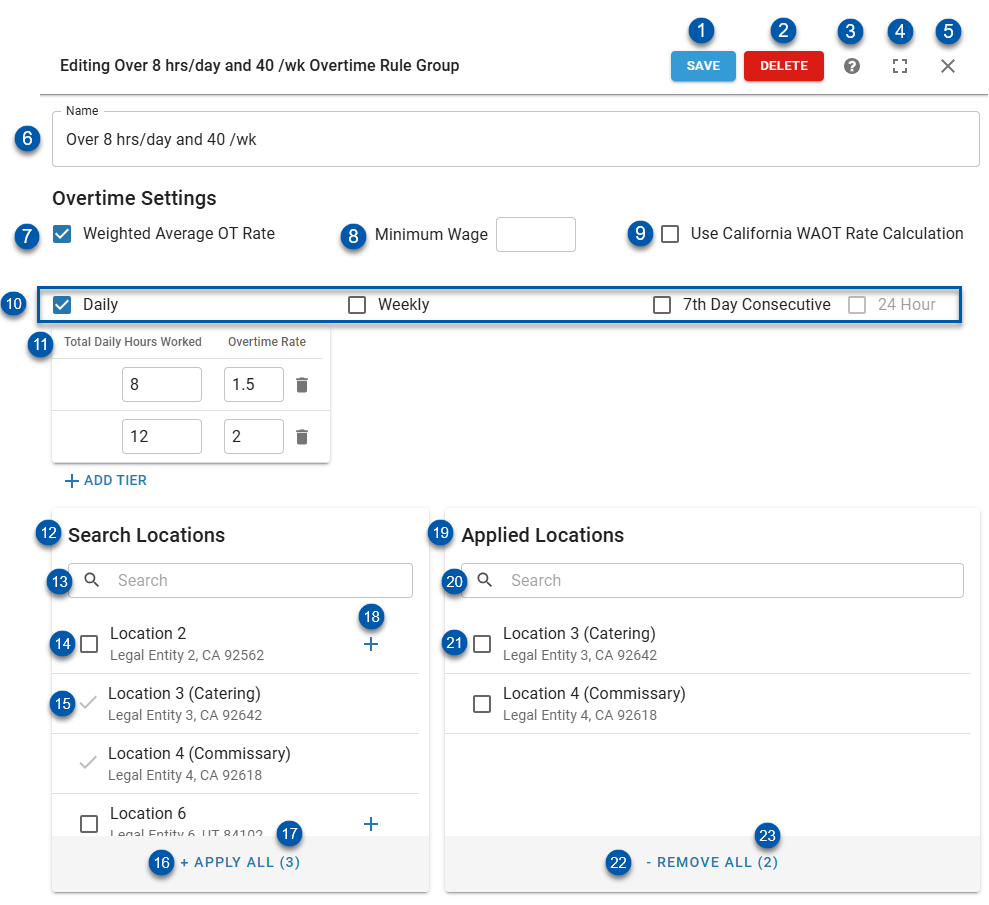
Button/Field | Description | |
|---|---|---|
1 | Save Button | Saves changes to the overtime rule. |
2 | Delete Button | Deletes the overtime rule. |
3 | Help Button | Opens the contextual help menu. |
4 | Expand Button | Expands the sidesheet to full screen, or collapses it when already expanded. |
5 | X (Close) Button | Closes the overtime rule without saving. |
6 | Name | User-entered name for the overtime rule. |
7 | Weighted Average Overtime (WAOT) | Indicates if OT premium rate is calculated for all employees who work multiple jobs. Learn more about WAOT calculations. |
8 | Minimum Wage | Minimum wage used as the ‘Job Rate’ in WAOT calculations for employees receiving the tipped minimum wage. Learn more about WAOT calculations.
|
9 | Use California WAOT Rate Calculation | Indicates if the California calculation method for weighted average overtime is used instead of the federal calculation method. Learn more about WAOT calculations.
|
10 | Overtime Types | Indicates which overtime types are enabled. Overtime is calculated for all enabled overtime types: Daily - Overtime is calculated when the employee exceeds a specific total number of hours for a business day.
Weekly - Overtime is calculated when the employee exceeds a specific total number of hours in a week. 7th Day Consecutive - Overtime is calculated when the employee works all seven days during a week. 24-Hour - Overtime is calculated when the employee exceeds a specific total number of hours in a 24-hour period.
|
11 | Overtime Settings | Overtime calculation thresholds for the overtime type. See overtime types below for additional field information. |
12 | Available Locations | Locations that the rule has not been applied to.
|
13 | Search - Search Locations | Filters the Search Locations list for locations with the entered text. |
14 | Available Locations | Locations that the rule has not been applied to. Check the checkbox to select the location for bulk edit. |
15 | Already Applied Location | Location that the rule has already been applied to. Indicated with a checkmark. |
16 | Plus Button | Applies the rule to the associated location. |
17 | Available Location Count | Number of available locations. |
18 | +Apply All/+Apply Selected Button | When no available location checkboxes are checked, the +Add All button is displayed, which applies the rule to all available locations. When one or more available location checkboxes are checked, the +Add Selected button is displayed, which applies the rule to the selected locations. |
19 | Applied Locations | Locations that will calculate overtime earnings using the configurations of this rule.
|
20 | Search - Applied Locations | Filters the Applied Locations list for locations with the entered text. |
21 | Applied Location | Location that the rule has been applied to. Check the checkbox to select the location for bulk edit. |
22 | -Remove All/-Remove Selected Button | When no applied location checkboxes are checked, the -Remove All button is displayed, which removes the rule from all locations. When one or more applied location checkboxes are checked, the -Remove Selected button is displayed, which removes the rule from the selected locations. |
23 | Applied Locations Count | Number of applied locations. |
Overtime Types Buttons & Fields
Daily, Weekly, and 7th Day Consecutive Types
The configuration for the Daily, Weekly, and 7th Day Consecutive types all use the same layout. These types all contain a field for the hour threshold and a field for the overtime rate multiplier. If needed, additional tiers can be added to these types if the overtime rate multiplier changes after an additional threshold is met.
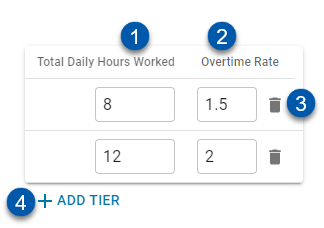
Button/Field | Description | |
|---|---|---|
1 | Hours Worked | The threshold at which additional worked hours will have the overtime rate applied. |
2 | Overtime Rate | The multiplier applied to hours worked past the associated threshold. |
3 | Trashcan Button | Deletes the threshold tier.
|
4 | +Add Tier Button | Adds an additional tier to the overtime type.
|
24-Hour Type
The 24-Hour overtime type configuration and can be set up as 'Qualifying Wage' or 'Consecutive'.
Qualifying Wage
The 'Qualifying Wage' configuration for 24-hour overtime will calculate overtime for any employee who has a wage less than the entered 'Qualifying Wage'. Any hours worked over the total hours threshold within 24 hours of each starting punch will be overtime. With this configuration, the hours worked do not need to be consecutive.
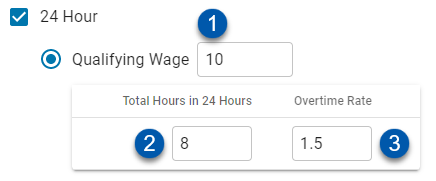
Button/Field | Description | |
|---|---|---|
1 | Qualifying Wage | Employees with an hourly rate less than this amount will be eligible for 24-hour overtime. |
2 | Total Hours in 24 Hours | The threshold at which additional worked hours will have the overtime rate applied. |
3 | Overtime Rate | The multiplier applied to hours worked past the associated threshold. |
Consecutive
The 'Consecutive' configuration for 24-hour overtime will calculate overtime for all hourly employees. With this configuration, the hours worked within a 24-hour period must be consecutive to qualify for 24-hour overtime. Consecutive hours are any hours that are separated by less than a specified number of off-the-clock minutes.
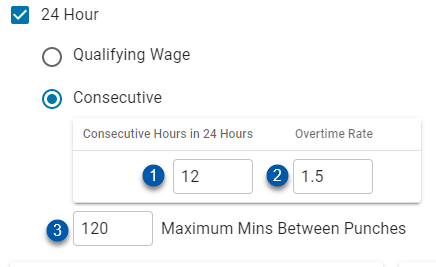
Button/Field | Description | |
|---|---|---|
1 | Consecutive Hours in 24 Hours | The threshold at which additional worked hours will have the overtime rate applied. |
2 | Overtime Rate | The multiplier applied to hours worked past the associated threshold. |
3 | Maximum Mins Between Punches | The maximum off-the-clock minutes between worked hours. If more than this amount of off-the-clock minutes are present between punches, the hours will not be considered consecutive. |